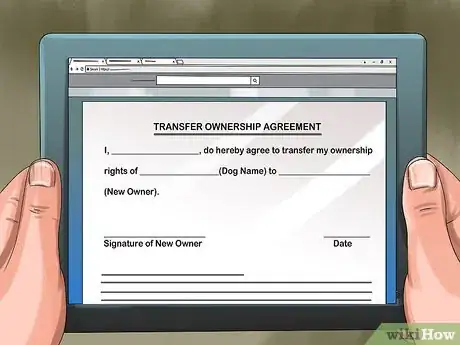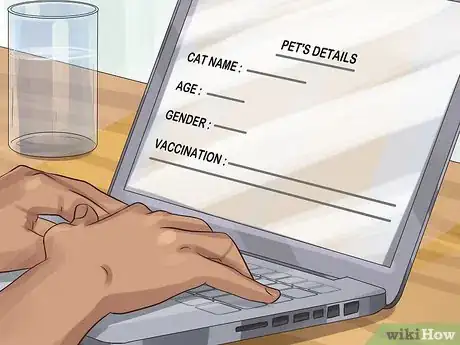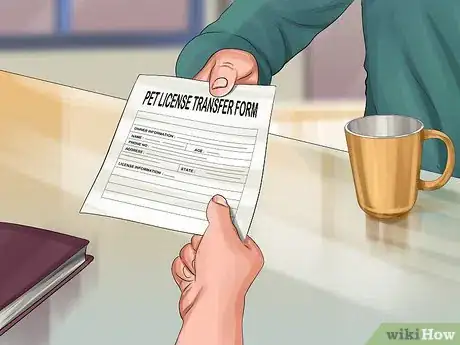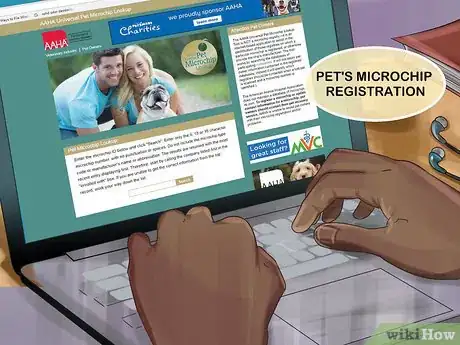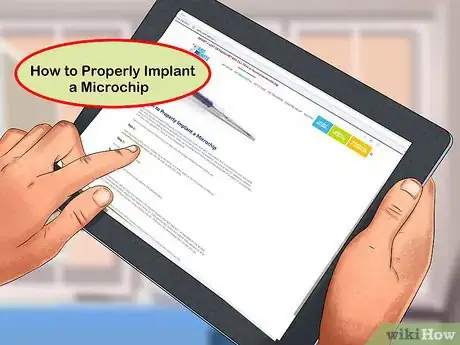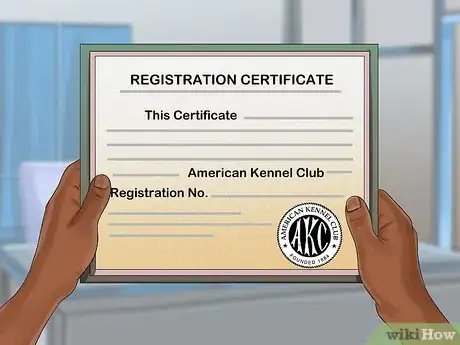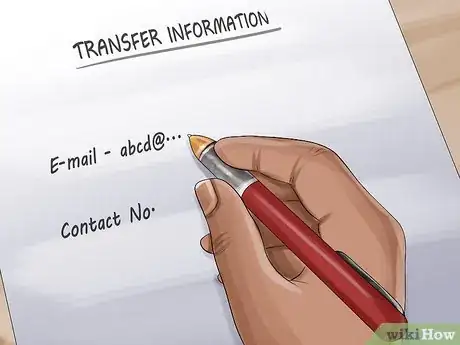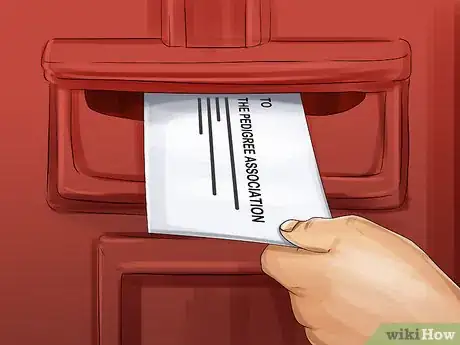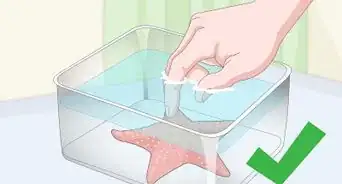This article was co-authored by wikiHow staff writer, Jennifer Mueller, JD. Jennifer Mueller is a wikiHow Content Creator. She specializes in reviewing, fact-checking, and evaluating wikiHow's content to ensure thoroughness and accuracy. Jennifer holds a JD from Indiana University Maurer School of Law in 2006.
There are 8 references cited in this article, which can be found at the bottom of the page.
This article has been viewed 125,427 times.
Learn more...
When you adopt a pet, it becomes like a member of the family. But sometimes, for reasons beyond your control, you have to let someone else take ownership of your pet. A written contract is a good way to transfer pet ownership if you want to specify care and treatment. If your pet is microchipped, that ownership also must be transferred, along with local licenses. Pedigreed pets, particularly cats and dogs, should have their ownership transferred with the pedigree association as well.
Steps
Drafting a Transfer of Ownership Agreement
-
1Discuss pet care with the new owner. As much as your pet is your friend and companion, they are treated as property under the law. You don't need to make any special agreements with the new owner regarding care and treatment, but you can if you want.[1]
- For example, you may want your pet to continue going to the same vet. If the new owner lives in the same town as you, they may agree to do this.
- If your pet is currently taking any medications, discuss this continued treatment with the new owner. Make sure they understand the dosing schedule.
-
2Search the internet for templates and samples. Many nonprofit pet adoption services have sample transfer of ownership agreements that you can use for your own purposes. Just remember to adapt the agreement to suit your needs. Don't copy clauses verbatim if you don't understand them or they don't apply to your situation.[2]
- For example, if you and your new owner live in North Carolina, you wouldn't want to copy an agreement clause that stated the agreement was governed by the laws in the state of California.
- Pet attorneys and legal document websites also have sample transfer of ownership agreements you can use. Some of them will charge a fee for you to access or create these documents.
Advertisement -
3Include information about yourself and the new owner. List the full legal names of both yourself and the new owner, and state that you are transferring full and complete ownership of the pet from yourself to the new owner.[3]
- State the address of the primary residence of both you and the new owner. You may also want to include additional contact information, such as phone numbers or email addresses.
-
4Provide details about the pet. The transfer of ownership agreement should include a description of your pet, including the animal, breed (if appropriate), and coloration. You may also include your pet's name if you want.[4]
- Many transfer of ownership agreements also include medical information about the pet, such as a record of veterinary checkups and vaccinations. You may also want to disclose if your pet has any diagnosed medical conditions, such as a heart murmur or hip dysplasia.
- Include license or tag numbers and any registration or microchip numbers associated with your pet. Add a disclaimer that these numbers will be transferred to the new owner. Typically this is your responsibility as the old owner of the pet.
-
5Add proper disclaimers and choice of law. Once you and the new owner sign the agreement, it will be a legally binding document. Like any legal contract, your agreement should include standard provisions stating that the document represents the entire agreement between you and the new owner.[5]
- If both you and the new owner live in the same state, you can simply provide that the agreement will be governed by the laws of the state in which you both live. If you live in different states, discuss the issue with the new owner.
- You also want to state where and how the agreement can be enforced. You can elect to go to court to enforce the agreement if necessary, or you can provide for mediation or arbitration. While it's unlikely you'll have to do this, the point of a written contract is to make sure all bases are covered.
-
6Sign the agreement. Once the agreement is drafted, it should be signed by both you and the new owner. Make and sign two copies so that both you and the new owner have an original with original signatures.[6]
- In most states it isn't necessary to sign your agreement in front of a notary. However, you may want to do so to prevent disputes later on. For example, the new owner could claim they never signed the document. A notarized signature would prove they had.
Transferring Licenses and Microchips
-
1Fill out a license transfer form. Pet licenses are issued by the city or county where you live. You can pick up a transfer form at animal shelters, or from many veterinarians. You may also be able to download a copy of the form online.[7]
- The form requires information about you and the new owner, as well as basic information about the pet. You will have to include the pet's license number, and typically a brief description of the animal.
-
2Sign the form in the presence of a notary if required. The license transfer form typically must be signed by both you and the new owner. Some cities or counties will require you to sign in front of a notary. Look on the form to see if there is a block for a notary signature and seal.[8]
- Once you've signed the form, make two copies so both you and the new owner will have a copy for your personal files. You'll have to turn in the original to the city or county animal control authority.
-
3Submit your form in person if necessary. Some cities or counties require you to bring your form in person to an animal shelter or animal control office. Typically both the old owner and the new owner are required to be present.[9]
- There typically isn't a fee to simply transfer the license to a new owner. However, if the new owner wants to have a new license number issued, or wants new tags printed, they may have to pay a fee.
-
4Find out where your pet's microchip is registered. If your pet is microchipped, that microchip is registered with a particular registration service. Some city and county governments have their own agreements with these services, so they'll transfer microchip registration along with the pet's license. Typically, though, you'll have to do this separately.[10]
- If you're not sure which service registers your pet's microchip, you can find out by looking up the microchip number at http://www.petmicrochiplookup.org/.
-
5Follow the microchip registration service's instructions. Each registration service has its own process for changing ownership of the microchip registration. Some require payment of a fee, while others do not.[11]
- In most cases, it takes 2 to 3 weeks for the transfer of microchip registration to take effect.
Updating the Pet's Registration
-
1Locate the pet's registration certificate. If you have a pedigreed cat or dog, you'll have a registration certificate issued by the pedigree association. For cats, this may be a "blue slip" from the Cat Fanciers' Association (CFA).[12]
- Pedigreed dogs in the United States are registered with the American Kennel Club (AKC).[13]
-
2Fill in the transfer information on the back of the certificate. Registration certificates are organized similar to car titles. There are boxes on the back of the certificate that you can use to transfer registration of your pet from yourself to a new owner.[14]
- Make sure you provide a complete mailing address for the new owner. This is the address the pedigree association will use to mail the new owner a new certificate.
- Dogs may require a supplemental transfer form. This is usually the case if the dog has had more than 2 registered owners.
-
3Sign the certificate as the old owner. The new owner may not have to sign the registration certificate for the transfer. However, you must sign it as the old owner. After signing it, make a copy for your own records.[15]
- The procedure for dogs is slightly different. There is another section of transfer information that must be completed and signed by the new owner. The new owner then sends the certificate to the AKC.[16]
-
4Mail the certificate to the pedigree association. Beneath the boxes for transfer information on the back of the certificate, you'll find the address where you need to send the certificate. The pedigree association will send a new certificate to the new owner.[17]
- Include a check or money order for the transfer fees. These fees are typically around $20 or $30. Check the website of the pedigree association to find up-to-date fee information.
Warnings
- This article only covers the transfer of pet ownership in the United States. If you live in a different country, the rules may be different. Your veterinarian or staff at a local pet adoption center may be able to help.⧼thumbs_response⧽
- This article only handles the transfer of pet ownership between two living owners. If the pet's previous owner has died, look to the previous owner's will or consult a probate attorney about transferring the ownership of the pet.⧼thumbs_response⧽
References
- ↑ https://fidolove.com/wp-content/uploads/2016/03/Dog-Adoption-Rehoming-Agreement-v2.pdf
- ↑ https://fidolove.com/wp-content/uploads/2016/03/Dog-Adoption-Rehoming-Agreement-v2.pdf
- ↑ http://stola.org/pdf/stolatransownshp.pdf
- ↑ https://bestfriends.org/resources/rehoming-dog-or-cat#Sample
- ↑ http://stola.org/pdf/stolatransownshp.pdf
- ↑ https://fidolove.com/wp-content/uploads/2016/03/Dog-Adoption-Rehoming-Agreement-v2.pdf
- ↑ https://www.seattle.gov/Documents/Departments/AnimalShelter/TransferOwnership.pdf
- ↑ https://www8.miamidade.gov/global/service.page?Mduid_service=ser1463496884910805&Mduid_location=org1450714342984597&Mduid_organization=org1450714342984597
- ↑ https://www8.miamidade.gov/global/service.page?Mduid_service=ser1463496884910805&Mduid_location=org1450714342984597&Mduid_organization=org1450714342984597
- ↑ https://fidolove.com/microchip-registration-changing-ownership/
- ↑ https://fidolove.com/microchip-registration-changing-ownership/
- ↑ http://cfa.org/Registration/FAQs/RegistrationFAQs.aspx
- ↑ http://www.akc.org/register/information/transfer/
- ↑ http://www.akc.org/register/information/transfer/
- ↑ http://cfa.org/Registration/FAQs/RegistrationFAQs.aspx
- ↑ http://www.akc.org/register/information/transfer/
- ↑ http://cfa.org/Registration/FAQs/RegistrationFAQs.aspx
About This Article
Giving your pet away can be emotional, but properly transferring its documents will ensure the new owner knows how to care for it. To transfer a pet to someone else, you’ll need to sign a transfer of pet ownership agreement and transfer your pet license and microchip registration. You can find templates for transfer of pet ownership agreements online. Make sure to include details about your pet including its breed, health history, and care instructions. Once you’ve signed the transfer, you’ll need to fill out a pet license transfer form, which can be found at most animal shelters. If your pet is microchipped, visit the provider who microchipped your animal to transfer the registration over. To learn how to find out if your pet is microchipped, read on!

